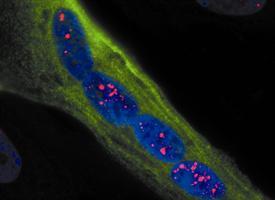
Deposits of toxic RNA (red) are seen here
inside muscle cell nuclei (blue) from an individual
with myotonic dystrophy.
Scientists have reversed symptoms of myotonic muscular dystrophy in mice by eliminating a buildup of toxic RNA in muscle cells. The work, carried out by scientists at the University of Rochester Medical Center, Isis Pharmaceuticals Inc. and Genzyme, is published in the August 2 issue of Nature.
After experimental antisense compounds were administered to mice twice a week for four weeks, symptoms of the disease were reduced for up to one year – a significant portion of a mouse's lifespan.
The investigators say that while the work is an encouraging step forward against myotonic dystrophy, one of the most common forms of muscular dystrophy, it's too soon to know whether the approach will work in patients. But they are cautiously optimistic, noting that the compound is extremely effective at reversing the disease – whose genetic underpinnings make it particularly vulnerable to an antisense approach – in a mouse model.
These results give us strong encouragement about the possibility of developing a treatment that could fundamentally alter the disease. It's an important step on a long path,
said senior author Charles Thornton, M.D., a neurologist at the University of Rochester Medical Center who has been pursuing new treatments for the disease for more than two decades.